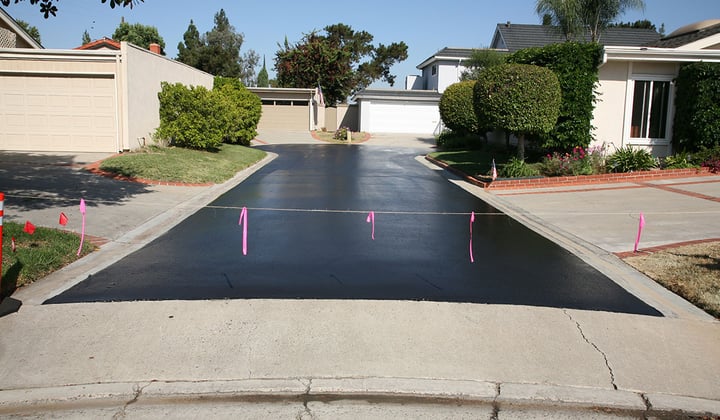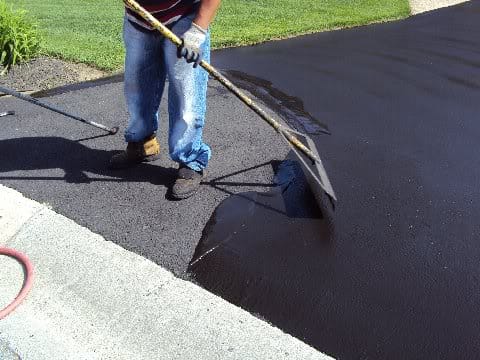Enhance Longevity: Warm Mix Asphalt Sealing for Angled Parking Structures
Enhance Longevity: Warm Mix Asphalt Sealing for Angled Parking Structures
Blog Article
Hot Mix Asphalt: A Sustainable Option for Pavement
Hot Mix Asphalt (HMA) has actually emerged as a leading lasting choice for sidewalk options, using a myriad of ingenious innovations and ecological advantages. As the demand for environmentally friendly construction techniques grows, discovering the subtleties of HMA's sustainability can provide beneficial insights into the future of sidewalk services.
Environmental Advantages of Hot Mix Asphalt

Moreover, Warm Mix Asphalt aids to minimize metropolitan warmth island effects. Its dark shade soaks up sunlight, decreasing the amount of warmth reflected back into the ambience compared to lighter-colored pavements. This can decrease ambient temperature levels in metropolitan areas, lowering the need for air conditioning and inevitably reducing power intake.
Furthermore, Warm Mix Asphalt adds to improved stormwater administration. Its porous nature allows water to penetrate the pavement and reenergize groundwater materials, minimizing runoff and the danger of flooding. These ecological benefits make Hot Mix Asphalt a sustainable option for leading highways and roadways.
Power Efficiency in HMA Production
Is energy effectiveness a vital variable in the manufacturing of Warm Mix Asphalt (HMA)? Power plays a substantial function in the manufacturing of HMA, influencing both cost and ecological sustainability. One essential element of energy effectiveness in HMA production is the use of cozy mix asphalt (WMA) technologies.
Additionally, improvements in plant innovations have actually resulted in even more energy-efficient HMA manufacturing procedures. Modern plants are made with features like recycled asphalt pavement (RAP) handling capabilities, efficient burner systems, and boosted insulation, all adding to power savings. By enhancing energy use in HMA manufacturing, the sector can lower its carbon impact while preserving top quality pavement products. Power efficiency is, as a result, a critical factor to consider in guaranteeing the sustainability of Warm Mix Asphalt manufacturing.
Recyclability of Warm Mix Asphalt
The recyclability of Warm Mix Asphalt (HMA) is a critical element of its sustainability and long-lasting environmental impact. HMA is one of one of the most recycled materials in the United States, with over 100 million lots of recovered asphalt sidewalk (RAP) being reused every year in new sidewalk building. Reusing HMA offers several environmental benefits, such as minimizing the requirement for virgin products, lowering power consumption during production, and decreasing the amount of waste sent to land fills.
The process of recycling HMA includes grating the existing pavement, crushing it into smaller items, and mixing it with new accumulation and asphalt binder to create a recycled mix. Generally, the recyclability of HMA plays a significant function in promoting sustainable techniques within the sidewalk industry.

Long-Term Efficiency of HMA
Asphalt pavements show toughness and resilience over an extensive period, reflecting the long-term efficiency of Hot Mix Asphalt (HMA) The longevity of HMA can be associated to its capacity to withstand hefty website traffic lots, rough climate condition, and the results of aging. Researches have shown that properly designed and properly built HMA pavements can last for 20 years or more with routine maintenance. The trick to maximizing the i was reading this long-term efficiency of HMA exists in using premium materials, adhering to ideal techniques in construction, and executing reliable upkeep approaches. Proper drainage, regular inspections, and prompt fixings are vital for maintaining the architectural integrity of HMA pavements over time. Furthermore, advancements in HMA modern technology, such as using polymer-modified binders and warm mix asphalt, have further improved the toughness and long life of HMA sidewalks. By prioritizing high quality construction and upkeep practices, HMA proceeds to show itself as a lasting and affordable option for long-lasting sidewalk framework.

HMA: Toughness and Sustainability
Showing both sturdiness and sustainability, Warm Mix Asphalt (HMA) has actually ended up being a foundation in the building of lasting pavement facilities - hot mix asphalt. HMA's longevity originates from its capability to withstand hefty tons, rough weather conditions, and high web traffic quantities, making it a reliable option for roadways, freeways, and airport paths. The make-up of HMA, which normally includes aggregates, binder, and filler, plays a crucial function in enhancing its longevity and resistance to tear and wear
Moreover, HMA's sustainability hinges on its recyclability and energy-efficient manufacturing procedure. The ability to recycle recovered asphalt pavement (RAP) in new HMA combinations minimizes the demand for virgin materials and reduces the ecological impact of pavement building and construction and maintenance. Additionally, the energy effectiveness of producing HMA depends on its reduced blending temperatures compared to other pavement materials, bring about reduced energy usage and greenhouse gas exhausts.
Verdict
Finally, warm mix asphalt (HMA) uses a lasting option for pavement with its environmentally friendly attributes. HMA's recyclability, power effectiveness in manufacturing, and lasting longevity make it an environmentally friendly option for road building. By conserving all-natural resources, minimizing waste, and reducing greenhouse gas discharges, HMA plays a critical role in advertising sustainability informative post in framework growth. Its capability to mitigate urban warmth island impacts further emphasizes its relevance in producing resistant and environmentally aware pavement systems.
HMA is one of the most recycled materials in the United States, with over 100 million lots of redeemed asphalt pavement (RAP) being reused annually in new sidewalk building.The procedure of recycling HMA includes grating the existing sidewalk, squashing it into smaller sized pieces, and blending it with brand-new accumulation and asphalt binder to create a recycled mix.Asphalt sidewalks show durability and durability over a prolonged duration, reflecting the lasting efficiency of Warm Mix Asphalt (HMA) Furthermore, advancements in HMA technology, such as the use of polymer-modified binders and cozy mix asphalt, have additionally boosted the resilience and durability of HMA pavements. The capacity to recycle recovered asphalt Look At This pavement (RAP) in brand-new HMA blends reduces the demand for virgin products and lessens the ecological influence of sidewalk construction and maintenance.
Report this page